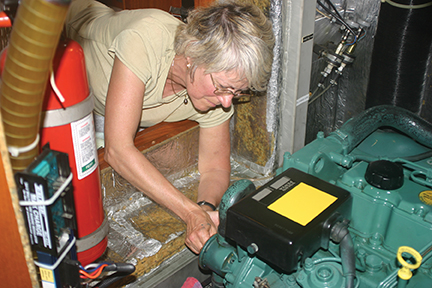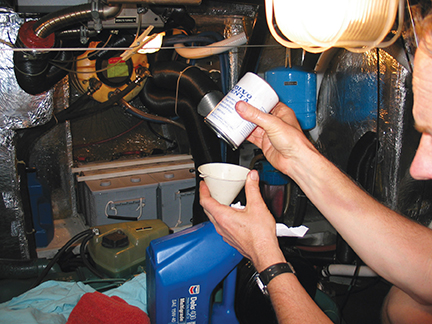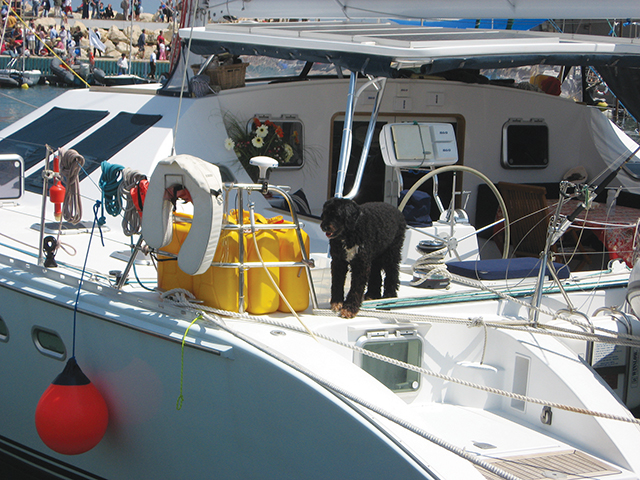Here is an introduction to your annual diesel engine maintenance program (published April 2014)
Taking care of your diesel engine(s) is one of the fundamental jobs on any cruising boat. We say engines with an “s” because many skippers have catamarans with two primary diesels and many monohull owners also carry diesel gensets. If your diesels are not functioning properly, the cruising life will definitely be under a dark cloud until they do.
Every engine manufacturer provides in-depth owner’s manuals and repair guides for each model and a parts manual for each engine. You should have these on your boat and should be familiar with them. Following the manufacturer’s recommendations for all aspects of your diesels is the best way to keep them running smoothly and reliably.
There are five basic aspects to your diesels that require regular attention and also a thorough annual maintenance routine: cooling, lubrication, fuel, aspiration and installation.
 COOLING
COOLING
Every time you start your diesel engines you should make sure that the internal cooling system is topped up and functioning properly. And you need to make just as certain that the raw water side of the cooling system is pumping water through the engine at the required rate. If you have any doubt about either system, shut the engine down and inspect the raw water strainer and water pump impeller for blockage or damage. And, check the internal coolant’s expansion tank to make sure there was not an air bubble giving a false reading when you first checked it.
Diesels run under a lot of internal pressure and therefore can overheat far more quickly than a gas engine. Overheating will shorten the engine’s life dramatically if allowed to persist. For the annual inspection you will need to go over both sides of the cooling system thoroughly. On the raw water side, check the through-hull intake to make sure the seacock is clear of growth and functioning. Check the hoses and hose clamps to the strainer and clean slime and any seaweed from the strainer. Check the hose to the anti-siphon valve and then take the top off the valve, clean it and make sure it is working properly. Check the hose to the heat exchanger and all clamps.
The raw water heat exchangers will be the most likely cause for an engine to overheat since they are constantly exposed to raw water and have small compartments inside them, normally copper lined, where marine growth can take up residence and obstruct water flow. You need to clean the heat exchangers annually.
 On some engines, you can take the exchanger ends off so you can clean the internal surfaces with a small, long-handle brush. On others, this is not possible. A good way to clean the inside of the exchangers and the raw water system of growth is to run a solution of fresh water and muriatic acid through the system. Mix up two five gallon pails with a rich muriatic solution and then run the hose from the strainer into the bucket just as you would when winterizing an engine. Run the engine until all of the muriatic solution has been sucked into the system. Let is sit inside the engine for 15 minutes and then flush it by running raw water through in the normal way.
On some engines, you can take the exchanger ends off so you can clean the internal surfaces with a small, long-handle brush. On others, this is not possible. A good way to clean the inside of the exchangers and the raw water system of growth is to run a solution of fresh water and muriatic acid through the system. Mix up two five gallon pails with a rich muriatic solution and then run the hose from the strainer into the bucket just as you would when winterizing an engine. Run the engine until all of the muriatic solution has been sucked into the system. Let is sit inside the engine for 15 minutes and then flush it by running raw water through in the normal way.
The raw water system’s impeller should be changed annually prior to commissioning. If the boat has been idle for any length of time, the impeller will become brittle and liable to fail while in service. As you change the impeller, check the pump’s driveshaft for wear and replace O-rings and seals as necessary.
Check the exhaust manifold for any corrosion or deterioration. You should inspect the elbow carefully since this is often a failure point. Check the exhaust hoses and clamps, inspect the water lift muffler for any leaks or cracks and finally inspect the exit exhaust hoses for any kinks, cracks or rusted clamps. Replace any clamps or hoses that look old, discolored or cracked.
You will find several zincs in the raw water system and these need to be replaced at least annually. Carry plenty of spare zincs since you may find yourself in a marina for a while where there is a lot of ambient electricity in the water that will kill your zincs and possibly corrode a lot more exposed metal if left unprotected.
The fresh water side of the cooling system should be flushed annually and the anti-freeze solution replaced. Use the antifreeze or coolant recommended by the engine’s manufacturer. Check the fresh water pump to make sure the seals are good and that it is operating at the correct pressure. Check the hoses and clamps running to and from the expansion tank and check the tank and cover for any leaks.
A diesel that runs at its prescribed temperature will provide thousands of hours of reliable service. An engine that is allowed to seriously overheat will have a much shorter life.
LUBRICATION
As every diesel owner knows, you have to change the engine’s crank case oil and filter every 100 hours. Do this reliably and you will be rewarded with long service. Fail to change the oil and you will see your engine deteriorate steadily as the cylinder walls or sleeves and rings wear and the engine loses pressure.
For the annual service prior to commissioning, replace any oil that has been sitting for a length of time with a fresh batch and replace the filter, even if it has only a few hours on it. Oil perishes as time goes by and as it sits. Do not use bargain basement oil or filters. Only use the oil and filters recommended by the manufacturer.
Make sure all seals around the oil pan and valve cover are in good condition and that there are no leaks.
For a normal transmission, change the transmission fluid every 500 hours but check it every time you check your oil levels. That should be at the start of every day before running the engine.
For a saildrive unit, you will want to change the transmission fluid as you would with a standard transmission. The lower unit needs to be serviced, too, and the internal oil replaced and zincs renewed. The main seal around the saildrive unit should be inspected carefully and renewed at the intervals specified by the manufacturer.
FUEL
If you laid up your boat for a season or so then you should have topped off your diesel tanks and added a diesel treatment with an alcohol base. This will help to reduce the amount of condensation in the tanks and thus water in your fuel.
Your fuel system delivers diesel from the tanks to the fuel pump and injectors via the gross and fine fuel filters and then pumps the unused fuel back into the tanks. Essentially, the system is cleaning the fuel all the time. The key players in the system are the filters because there is nothing a diesel engine likes less than fuel with water, dirt or algae in it.
During the annual haul out or commissioning replace your gross filters, Racors, for example, and clean the filter housings and bowls. Two gross filters are better than one, particularly if you can bypass one for the other if necessary. FilterBoss has a great system for managing your fuel filters. Replace the fine filter mounted on the engine with a new one. But if you get water or dirt in the fuel, you will have to change the filter more often.
Follow the owner’s manual for the intervals for filter replacement.
If you have taken on bad fuel, you may need to have the whole tank load run through a polishing system. In a worst-case scenario, you may find that your tanks have developed an algae bloom. Yes, algae in the tanks grows in small reservoirs of water and feeds on the petroleum. In this case you will have to empty your tanks, remove the inspection ports and give the tanks a thorough cleaning with dry rags and alcohol.
In developing countries, you need to filter new fuel as it goes into the tanks with an aviation-gas filter or a Baja filter. You can use pantyhose, too, in a pinch.
The high pressure fuel pump needs to be adjusted by a certified diesel mechanic and if you are headed to regions where mechanics are scarce you should consider carrying a new high pressure pump with you. Annually, it makes sense to check all fuel injectors and to have the nozzles tested for the correct pressure function, spray pattern and seals. Replace the nozzles as needed and carry a spare injector and spare injector seals for safety’s sake.
ASPIRATION & HEAD
The exhaust and intake valves on the engine will need to be adjusted annually or every 1,000 hours or so. This is not difficult but if you have never done it before, it makes sense to have a certified mechanic show you how. You will need a feeler gauge, wrenches, and the engine manual with the settings and the tightening sequence.
Once you have the valves adjusted, you should torque down the engine’s head with a torque wrench. Again, have a mechanic show you how to do this if you have not been through the process before.
With the valves adjusted and the head torqued down, run the engine for half an hour or so and then let it cool down. Once cool, you can measure the valves again and readjust them as necessary. The head should be fine.
BELTS
The belts on the engine need to be replaced at regular intervals since they will tend to wear and stretch over time. The old belt should be removed and then the new belt of the correct size and width installed and tightened. The belt needs to be tight enough that it only moves a finger’s width as you press down on it. Set it up too tightly and it will bind and wear quickly. If it is too loose it will not deliver the correct power to the alternator and water pumps.
On engines that have high output alternators, you will find double belts or wide belts. Remember that dual belts are sold as matched pairs. You cannot simply use two that are of roughly the same size. With flat belts, check them for cracking along the sides and for any signs of wear such as black dust on the alternator or brackets.
ENGINE MOUNTS & ALIGNMENT
 Once the boat is back in the water it is time for the final annual maintenance task on your engine. You don’t want to adjust the prop shaft’s alignment to the transmission and engine when the boat is on the hard because the hull will deflect somewhat as it rests in jack stands. Once in the water, the boat returns to its true shape and that will allow you to align the engine accurately and permanently.
Once the boat is back in the water it is time for the final annual maintenance task on your engine. You don’t want to adjust the prop shaft’s alignment to the transmission and engine when the boat is on the hard because the hull will deflect somewhat as it rests in jack stands. Once in the water, the boat returns to its true shape and that will allow you to align the engine accurately and permanently.
If you have a soft coupling between the shaft and the transmission, you do not have to be too meticulous about alignment. But if you are bolting steel plates together, you need to get them as closely aligned as possible. An engine and shaft that is out of alignment can damage the transmission, the stern gland and stuffing box, and even cause the shaft to work harden and break.
To start the alignment, unbolt the four bolts that hold the shaft plate to the transmission plate and loosen the fourth so the two plates are free of each other. Take your feeler gauge and work it around the plates. If one side is tight and one loose, then you have to adjust the engine’s position on its mounts slightly from side to side. If the gap is at the top or bottom, you have to either raise or lower the engine on its front or back mounts until the plates fit flush together all the way around.
Aligning an engine can take several refinements as you use the boat and as the engine and shaft work together. Don’t be surprised if you have to repeat the alignment two or three times in the spring to get it just right.















